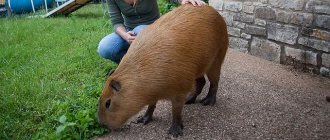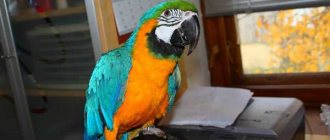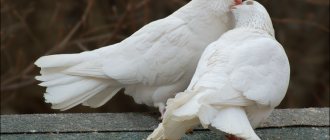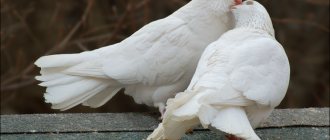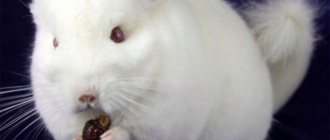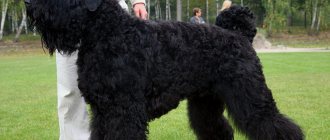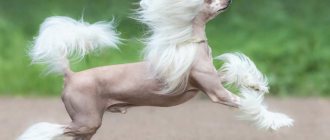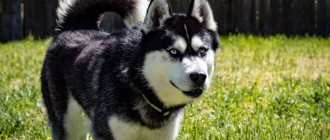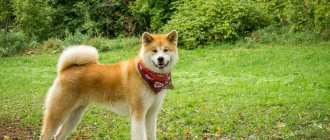- home
- Parrot
- Kinds
05/15/2019 Parrots are among the most ancient representatives of the fauna. The appearance of these birds has not changed from their appearance on the planet to the present day. United into one order, parrots have many differences from most birds. Parrots of all varieties are characterized by such characteristics as attractive appearance, beautiful plumage and color, sociability and learning ability, liveliness of character and unpretentiousness in care and maintenance. Thanks to these and other characteristics, parrots quickly gained popularity as pets. What kind of parrots there are and what features different types of these birds have will be discussed in this article.
How many species of parrots are there in the world?
Parrots, representing the order of the same name, are divided into two families:
- parrots;
- cockatoo.
In total, there are almost four hundred varieties of parrots in the world. These birds have both similar features characteristic of most birds of the order Psittacidae, as well as distinctive features inherent only to a particular species.
All parrots have:
- curved beak (or crossed);
- four toes on each paw, divided in pairs (two pointing back and two pointing forward).
Based on color, parrot varieties come in two types of plumage:
- bright or contrasting;
- camouflage.
In terms of size, parrot species differ significantly from each other. The sizes of birds of various breeds range from 8 cm to 1 m.
It is impossible to describe all breeds of parrots. But in order to partially appreciate the diversity of varieties of representatives of this order, it is worth taking a closer look at the most popular and widespread, famous and rare, remarkable breeds of parrot.
Where does the cockatiel live in the wild?
The natural range of nymphs is the central part of Australia. They are rarely found near the ocean; they are suitable for spacious plateaus, grassy plains, and thickets of bushes near rivers. Parrots of this species prefer to breed in tree hollows, and when the chicks grow up, the flock flies from place to place. Nomadic life is important during dry periods, as food and water become increasingly scarce. In a community, it is easier for birds to find food and escape from predators.
Budgerigar
This talking feathered baby is in great demand as a pet. The budgerigar leads the most common and popular species of pet parrots.
Australian in origin, budgerigars have a very attractive appearance. They are small in size - only 16–23 cm. At the same time, the weight is a maximum of 50 g.
The birds have bright colors. Mostly there are individuals with plumage of the following colors:
- green or herbal;
- yellow;
- blue or blue;
- white;
- black or dark gray.
Combinations of these colors, both symmetrical and chaotic, are not uncommon. In addition to the colors listed, through the efforts of breeders, an anthracite parrot was bred. Individuals with plumage of this color are quite rare. In addition, the pink and purple budgies are considered rare.
Regardless of the main color tone, black wavy lines are painted on the feathers that cover the wings, head and back, as if with an artist’s brush - this detail of the color of the plumage determined the appearance of the name of this species of parrots.
These small pet parrots are highly intelligent. They are easy to train and are able to imitate human speech. In addition, birds of this species are characterized by:
- friendliness;
- playfulness;
- curiosity;
- sociability;
- unpretentiousness in care;
- low feed consumption.
Despite their talkative nature, these pets do not make as much noise as you might expect.
The average lifespan of birds is 10–15 years, but with special care, a pet can live twice as long as the average.
Tips for buying a parrot
It is better to buy a chick from a professional breeder. And to make your task easier, you need to learn everything about Corella parrots in advance. It is recommended to visually evaluate:
- eye condition;
- quality of feather cover;
- beak integrity;
- cleanliness of the cloaca;
- condition of paws and claws.
Important! You should not buy a bird with cloudy, squinted eyes, stuck together or ruffled feathers, a deformed beak and a dirty cloaca.
Corella is an exotic parrot with a recognizable appearance and high intelligence. He is highly tamed and will be a good companion for those who are willing to put up with his habit of littering, making noise in the evenings and gnawing whatever he wants.
Macaw
This colorful parrot of South American origin has outstanding characteristics and parameters in literally everything. Dimensions – up to 1 m (including tail), this is the largest species of all existing ones. Life expectancy is from 30 to 90 years.
Macaw parrots look very impressive. The bright color of the bird with a large beak fits the entire palette of colors. Based on the main colors, representatives of these birds can be divided into 4 subspecies:
- Common macaws (colors predominate in red-blue and yellow-blue);
- hyacinth macaws (the largest and most expensive species of parrot in the world);
- blue macaws (the rarest, endangered species);
- Lesser Blue-fronted Macaws.
This bird of fabulous beauty is notable not only for its appearance. Macaws have good intellectual development, they are amenable to learning and training, they can speak - both in memorized phrases and unexpectedly say something overheard, depending on the situation. But the bird’s voice is unpleasant – sharp and shrill.
Macaws are friendly and sociable birds, but very noisy and capricious - like little children. In addition, such large parrots are not entirely suitable for keeping at home - they require too much free space. Therefore, they are most widespread in the following places:
- nature reserves;
- zoos;
- circuses, etc.
But there are still people who want to keep this parrot as a pet.
Corella
As domestic parrots, cockatiels (sometimes the breed is mistakenly called Karo) occupy second place in demand and prevalence, after wavy ones. These attractive Australian birds are called cockatiels in their homeland, but Europeans call them nymphs. They lead the popular species of medium-sized parrots.
A notable feature of the appearance of these birds is the expressive crested forelock on the head, which gives cockatiels some resemblance to cockatoos and thanks to which these parrots are also nicknamed crested. It is worth noting that the color of the crest always matches the general color of the parrot's head.
The colors of Corella parrots can be different, but without exception they are all interesting and have a camouflage character - the colors are muted and soft. The most common nymphs have a gray body and a yellow head with an orange blush on the cheeks. In addition, individuals of pearl, cinnamon and other colors have been bred.
The dimensions of cockatiels are 30–35 cm (including a long tail). The average weight reaches 90 g. They usually live up to 18–25 years. The main guarantee of a pet’s long life is good care and constant communication with the owner. Cockatiels cannot stand loneliness - lack of contact with humans is fraught with depression and illness for the bird (especially for representatives of the breed that talk).
Birds are distinguished by their friendliness and sufficient learning ability - after regular exercise, the pet can begin to talk. But still, the bird prefers singing and imitating various sounds that it hears around, from dog barking to the noise of technology, to talking. But you need to be prepared for the fact that the cute bird’s voice is loud and rather harsh.
Parrots for children and beginners
Birds are kept for children. The birds are unpretentious in care and maintenance, the child learns responsibility. The future pet is chosen based on financial capabilities, living space and the age of the child. Errors are possible. At the persistent requests of a child, sometimes a large parrot is purchased. It ends badly: the bird returns to the pet store or to the breeder. This is the best case scenario. At worst, she is rarely remembered and kept in disgusting conditions. The pet dies due to poor care.
To avoid such a situation, it is advisable to familiarize yourself with the breed of bird you plan to purchase.
Who to choose for a small apartment, a cockatiel or a budgie? The child insists on cockatiel. This bird requires a large cage and quite expensive food. Will adults be able to support it? Is there a secluded corner for a cage in the apartment? Will the cockatiel be comfortable there? By answering these questions, parents will be able to make a final decision.
Important! A budgerigar would be an ideal pet for children. He is small, cheerful, and learns to talk easily. With good care, it can live up to 15 years.
Which parrot is better to have at home if the space allows you to keep a large bird, but there is no experience in keeping it? There is only one recommendation - a budgerigar. A novice “poultry farmer” can take care of him.
Budgerigars
Which parrot is best for a child, other than a budgie? The bird is good for its unpretentiousness and cheerful disposition. Budgerigars quickly become tamed and make contact easily. Able to remember and reproduce 150-200 words. With regular training, they will delight the little owner with their achievements.
The parents decided to get a parrot for their child. How to choose a budgie?
- The male, up to 6 months old, has a pink-violet beak. With age it turns blue. The older the bird, the brighter the blue color of the beak;
- In young females, the color of the beak is soft pink. In individuals older than six months, it becomes darker. An adult or old bird has a brown beak;
- There are black waves on the heads of young birds. After 4 months they disappear or become almost invisible;
- The parrot's cloaca area should be clean. If the bird's feathers and cloaca are contaminated with droppings, the parrot is not healthy;
- A healthy bird is active. She chirps cheerfully and pesters her cage neighbors. A ruffled parrot with dull or closed eyes is sick.
- If you plan to further train your parrot to talk, the male is ideal for this. Females chat less often.
- The cost of a bird ranges from 800 to 1500 thousand rubles. Males are more expensive than females.
cockatiels
The choice of a parrot for a home is based on the desire of the future owners and the ability to keep this or that bird. If you want to buy a large parrot, but there is too little space in your apartment, the cockatiel will be an alternative.
The parrot is classified as medium. It is slightly smaller in size than a pigeon. Cockatiels are mostly gray in color. But light yellow and ivory-colored individuals can be found. The birds have a funny crest on their heads. Males differ from females in their red “blush” on their cheeks and their massiveness. Female cockatiels are rather small, they have pale cheeks and a shorter crest. A Corella will cost about 3500-4000 thousand rubles.
Lovebirds
How to choose lovebirds? There are several subspecies: pink-cheeked, masked, Fisher's, black-cheeked, black-headed, collared. The list can be endless. The most common are rosy-cheeked, masked and Fischer. They differ in appearance.
The highlight of pink-cheeked birds is the color of their heads. The main background is most often green. The head is green-white. The cheeks are pale pink.
The masked lovebird is the most beautiful. The upper part of the head, back and chest are bright yellow. The muzzle is black, with a clearly visible red beak. Large white eyes with black pupils complete the image of the bird. The lower back and body are green.
Fisher's lovebird can be green or yellow. Its muzzle is painted bright orange or red. The beak is yellow or red. Of all the subspecies, this is the most expensive.
Males and females cannot be distinguished by appearance. It is acceptable to keep one parrot, but it will be sad and lonely. He has been wary of his owners all his life. He sits on your hand if you really try and train him, flies around the room, and responds to his name. However, he doesn’t like unnecessary touches. A solitary lovebird is more comfortable in a cage than with a person.
A couple of lovebirds are quite noisy at home. Birds are busy only with themselves, “talking” in their own language. They scream loudly, and the scream is quite disgusting. Having a child is not an option. Suitable for an adult or a married couple without children. Not everyone can withstand constant screaming. A pair of lovebirds can cost up to 10,000 - 12,000 thousand rubles.
Cockatoo
These birds got their name due to their powerful beak. "Cockatoo" is a derivative of the Malay word "kakatua", which translates to "nippers". The beak of a cockatoo has a unique structure that allows the bird to:
- crack nuts;
- chew branches;
- bite through metal bars;
- pick locks, etc.
However, despite this, it is not the beak that is considered the main characteristic feature of the cockatoo, but the high, large crest located on the back of the bird’s head. In most individuals it is yellow or pink, but there are exceptions - for example, the Solomon species. This is the name of a white parrot with a crest of the same snow-white hue as the rest of the bird’s plumage. It is worth noting that neither green nor blue colors are found in cockatoo colors.
Despite the fact that cockatoos are large-sized varieties, they are quite popular as pet parrots. The size of the bird ranges from 30 to 70 cm (including the tail). The wingspan is 80 cm. The average lifespan is 40–50 years, but with careful care the bird can live up to 70 or even 90 years.
It is worth noting that the cockatoo cannot be called a friendly and affectionate pet. This aggressive and vindictive bird:
- bites often;
- terrorizes other pets;
- spoils everything that comes across - from furniture and interior items to flowers, wires, books, etc.
In a good mood, they are very playful and can amuse the owner - entertain him with dances, songs, stories, etc. (the cockatoo's voice is loud, ringing). But in order for the pet to switch to peaceful behavior and distract itself from antics and antics, it will have to be carefully trained.
Habitat of parrots
The habitat of this exotic bird is extremely wide. Preferably lives in tropical and subtropical climates. The largest population lives in Australia, the bird's probable homeland. Also common in Asia, India, Africa, South and Central America.
But lovers of warm countries, parrots, are also found in more extreme conditions, for example, at an altitude of more than 4 thousand meters in the Andes.
Also, birds that have undergone acclimatization have inhabited the territory of Western Europe, where their large flocks exceed several thousand individuals.
Lovebirds
These birds of African-Madagascar origin live in pairs and never move beyond earshot of their mate. It is highly not recommended to have one lovebird. Even if you give him maximum attention, he will still be sad and will not live long.
Many people believe that lovebirds are medium-sized parrots, but it is still more correct to classify them as small varieties. In size they reach 17 cm.
One of the differences between these birds and other species of parrots is that they have a short tail. Therefore, their size is determined by the length of the body. Another characteristic feature of birds of this species is their long beak, extended towards the bottom.
The physique of lovebirds is harmonious, and the plumage has bright contrasting colors. Parrots are colorful and elegant - nature has generously rewarded them with attractiveness. Different combinations of colors in their colors are possible. Most often in their plumage there are various shades of the following colors:
- green;
- red;
- orange;
- pink;
- blue;
- black;
- white;
- grey.
However, the “riot of colors” extends not only to the plumage. Lovebirds with lilac, green or red beaks are often found.
These cute couples are considered one of the most arrogant and impudent parrots. They rarely get along with other pets. These birds are different:
- glibness;
- loudness;
- curiosity;
- agility.
Talkativeness is not typical for lovebirds. Vocabulary – 10–15 words.
A little history of the species
The homeland of cockatiels is Australia. Animalist and ornithologist John Gould undertook a zoological expedition to the mainland in 1838–1840. He took out about eight hundred birds and seventy animals. Upon returning to Great Britain, the scientist systematized his works, the result of which was the book “Birds of Australia”. In the part dedicated to parrots, the ornithologist tells everything about cockatiels: their lifestyle, appearance.
Europe first saw cockatiels in the forties of the nineteenth century. From Paris, the birds, through the efforts of private breeders, spread throughout the European part of Eurasia. After 1960, Australia introduced a ban on the export of parrots outside the country. Further breeding and selection took place without the participation of wild representatives.
Jaco
Individuals of this species are considered the most intelligent and easily trained of all. Grays can remember over 1,500 words and imitate a variety of sounds. Remarkable abilities compensate for the discreet appearance. The main ash or black and white color is diluted with a reddish tail.
The average lifespan of a Gray Gray is 35–40 years; with special care, it can even celebrate its half-century anniversary. The bird is quite large - 35 cm, so keeping it at home is not so easy. But if there is readiness and opportunity, then with proper care the pet will show reciprocal love and become a reliable and loyal friend. The main thing is not to leave the bird idle and left to its own devices. Otherwise, she will either start to pull out her feathers or misbehave.
Eclectus
Laconic, but brightly colored Eclectus up to 37 cm. Males are often blue and green (beak red or yellow), and females are red with various inclusions (beak black). Therefore, the gender is easy to distinguish.
Lives up to 40 years.
Homeland - islands: Salamon, Moluccas and Taninbar. Also found in Australia and New Guinea.
Very calm, flexible in character, he received the name “noble”. It can love the owners more than the female. Affectionate, loves attention, loves to communicate with the owner. Very smart, the male makes contact more easily. They scream extremely rarely.
It is easy to learn how to clean: put back fallen food, put small items in a box.
Kakapo
This amazing feathered creature of New Zealand origin is famous for its resemblance to an owl. In particular, this concerns the structure of the head. The voices of these birds combine notes of owl hooting, pig grunting and donkey cries.
The color of the kakapo is camouflage. The color of the feathers is green interspersed with dark brown or black shades.
These rare birds, disappearing from the face of the Earth, and therefore listed in the Red Book and protected, are unique. Their wings are weak, which is why kakapos cannot fly. But this does not stop them from climbing trees. The waking time of these parrots is night.
Kakapo cannot be seen in zoos, much less at home. Scientists are now working to restore the once large population of this species.
Birds are unpretentious in care and nutrition
Kakariki or New Zealand parrots
Agile birds, mainly jumping on the ground. They inhabit the forests of New Zealand. These are calm, quiet parrots, especially the females.
Unpretentious kakariki parrot
In captivity, parrots are found with rich green, olive and sunny yellow plumage. Representatives of the species are characterized by a red coloration on the forehead, crown and horizontal stripe near the eye. Body length 23-27 cm.
Read also
New Zealand cockatiel parrot Birds
must be given the opportunity to bathe daily, otherwise prolonged molting may occur. It is interesting to watch pets while eating pieces of treats, which they hold in their paws, like large parrots.
Kakapo (owl parrot)
Due to its characteristics, this representative of parrots is assigned to a separate subfamily. This is an extremely rare species of bird living high in the mountains of New Zealand. Leads a terrestrial and nocturnal lifestyle. Kakapo feed on bush berries.
Unpretentious kakapo
The bird reaches 60 cm and has a rounded beak without a notch. The plumage is rich green, complemented by yellow, black and brown colors.
Kakapo is on the verge of extinction; as of January 2019, only 147 individuals of these birds are known. In order to preserve the species, birds are bred in captivity and released into areas free from predators. A very affectionate and good-natured parrot.
Kea or nestors
There are three species of nestors found in the wild. The most famous and widespread of them is Kea. This is a medium-sized bird that inhabits the highlands of the New Zealand Islands. The color is predominantly olive green.
Kea parrot
In their homeland, birds have a bad reputation and are known as bloodthirsty killers of sheep. In fact, these are herbivorous birds, which sometimes do not disdain insects, their larvae and carrion.
At home, kea are unpretentious in nutrition and can be easily tamed.
Congo parrot
It is also called Jardin's parrot in honor of its discoverer. Representatives of the species inhabit the African continent. Body length is 28-29 cm. The main part of the plumage is iridescent green, and the forehead, edge of the wing and “panties” are fiery red.
Congo parrot
Very smart birds, with intellectual abilities almost equal to Grays. They can conduct a dialogue with a person and also perform tricks. They are distinguished by their wayward character, often bite, trying to take a dominant position in the family.
Kea
This New Zealand parrot also bears little resemblance to most representatives of this order, just like the kakapo. An alternative name for this bird is Nestor. In size and build, this parrot with a long beak more closely resembles a crow. In rare cases, kea grows up to 50 cm and gains weight over 1 kg. The bird's body is powerful, its legs are strong.
Nestor's plumage is a camouflage olive color. The only exception is the area inside the wings with feathers in bright green and blue shades.
The character of kea is characterized by:
- curiosity;
- sociability;
- mischief.
Like kakapo, kea are protected by law.
Song breed of Rosella parrots
The cute Australian rosella parakeet does not speak, but sings – melodiously and pleasantly. The bird's voice is beautiful, expressive, and his manner of performance is calm. By nature, Rosellas are calm and friendly. But they will not be able to get along in the same cage with a bird of a different species - the sharing will end in a fight.
Rosella has average dimensions - 20–30 cm. The colors of the plumage are varied. Most individuals can be divided into two categories - those with a pale yellow head or those with a red head.
Reproduction
In nature, the nesting cycles of the cockatiel depend on the rainy season. This is due to the fact that it is easier to raise chicks when there is an abundance of water. All species of cockatiels breed twice a year: the first clutch is usually incubated in the fall, the second in mid-winter. The female lays five to seven eggs, which are incubated alternately with the male for 21 to 23 days. The parents feed the hatched chicks until they are approximately two months old, then the older generation leaves the nest. Having rested, the couple begins a new laying.
Corella parrot chick
A married pair of tame parrots can reproduce freely if favorable conditions are created:
- closer to autumn (or spring, if this time of year is chosen), you should start feeding the birds with a special vitamin mixture;
- add sprouted grains and calcium to food;
- gradually increase daylight hours to 16 hours;
- You need to prepare a nest box (house) in the cage.
Individuals must be at least two years old and not older than six years old. Inbreeding is undesirable, otherwise you may end up with defective, sick chicks with defects.
Monk (Kalita) – European pigeon
This fairly popular variety of pets in Spanish, Brazilian and other cities is considered a street pet and is comparable to Russian pigeons. These birds began to be called monks because of the similarity of the colors of their plumage with the cassock. The crown, back and tail are bright green or turquoise, and the front of the face and body are pale brown.
But the character of these talking birds is not at all monastic. They are characterized by:
- playfulness;
- curiosity;
- impudence.
These parrots are easy to tame. They are not particularly talkative. Vocabulary – several dozen words. The voice is hoarse, as they say, not for everybody.
Tamed parrot Amazon
In terms of intelligence, tropical Amazons are second only to Grays. Well-trained “talkers” have excellent memory - they remember words and sounds, and use them at the right moment, as they say, “on topic.”
A playful, friendly and cheerful parrot gives its owner only positive emotions. Amazons live up to 15–50 years (depending on the level of care and care). The size of the parrot is average - 25–50 cm. The body is strong, the tail is large. The plumage is bright with combinations of the following colors:
- green;
- white;
- yellow;
- red;
- blue;
- black.
Genus Amazon parrots
White-fronted Amazon
Jamaican Amazon
Cuban Amazon
Holiday Amazon
Yellow-fronted Amazon
Blue-fronted Amazon
grass parrot
Small parrots of Australian origin with dimensions of 20–25 cm in nature make low and short flights, so the cage for them should not be high, but long. The color options are varied, but mostly of a camouflage nature.
The bird's voice is melodious. The parrot only sings, does not talk. Life expectancy rarely exceeds 20 years.
Life expectancy and disease prevention
With proper care, Corella parrots live up to 20-25 years. In conditions of unsanitary conditions and nutritional deficiencies, birds can develop the following diseases:
- avitaminosis;
- obesity;
- gastroenteritis;
- dysbacteriosis;
- amyotrophy;
- violation of the structure of the beak and bones;
- parasitic infestations;
- feather loss and self-plucking.
To prevent the development of health problems, birds are provided with regular hygiene, adequate nutrition and timely veterinary care.

